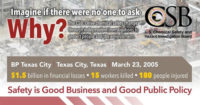ASSE President's monthly message
The business of safety

As OSH professionals, we talk about incident rates, reportable injuries and illnesses, workers’ compensation losses, experience modifier rates, regulatory compliance standards and similar metrics. Our language is clear in our professional circles, yet it is often confusing to business managers and executives. Their language is finance (or dollars, for short).
As management guru Peter Drucker said, “Economic performance is the first responsibility of business. . . without it, a business cannot discharge any other responsibilities, cannot be a good employer, a good citizen, a good neighbor.” In The Complete Idiot’s Guide to Finance and Accounting, Michael Muckian echoes Drucker: “It doesn’t matter what your professional responsibilities are, your management responsibilities contribute directly to your company’s profitability.”
What these two respected authors are telling us is that as part of a management team, we must communicate in the language that corporate leaders understand. We cannot expect senior management to communicate in our terms. Executives have a keen eye on the budget at all times, so when we seek resources we must justify our requests in terms that they understand.
But that’s not the whole picture. We also have to consider what Paul O’Neill, iconic Alcoa CEO, said: “I will fire the first accountant that asks for an ROI on a safety investment.” Or what safety management guru Dan Petersen said: “It is a very bad message to say safety is about dollars. The real message is: We are doing these things because we care about you, the company cares about you. Don’t even talk to me about doing safety for money.”
Faced with this conflicting advice, what are we as OSH professionals to do? How do we reconcile the focus on the bottom line versus the legal requirements and organizational responsibility to protect workers?
The good news is that as we implement policies, programs, processes and safeguards that protect workers from injuries and illnesses, we also help our organizations become more efficient, reduce costs and, in some cases, increase revenue. Will there be tension at times between operating budgets and safety spending recommendations? Absolutely, but such tensions are not unique to safety expenditures in any organization.
The solution to our dilemma is to recognize that our job is to be part of the management team whose purpose is to run the organization. That means working together to find solutions. The business of safety is no different than the day-to-day responsibility of handling the many decisions that managers continuously face.
During ASSE’s first-ever Executive Summit in 2004, Riley Bechtel, chair of Bechtel Corp., said that he expects his safety professionals to be part of his company’s collective leadership. In other words, help solve business problems as part of the leadership team, do not be the source of them. If we take that counsel to heart, we will make decisions that make our organizations stronger, implement processes that protect our workers better and, as a result of those actions, enhance our value in the eyes of managers and organizational leaders.
Over the past 15 years, I have taught several courses on the financial aspects of safety, including graduate courses at Tulane University and 1-day sessions at ASSE’s SeminarFest. I start each course with this disclaimer: “The most important reason for investing in workplace safety is not saving money, it is keeping people from getting hurt.” I do not want my students to lose sight of our bottom line as OSH professionals. However, to become the most effective safety advocates, we must also engage in business decisions that enhance our organizations’ bottom line. That is the true business of safety, and it is a win-win for everyone.
Click here to visit the president's message on the ASSE website.
Looking for a reprint of this article?
From high-res PDFs to custom plaques, order your copy today!






